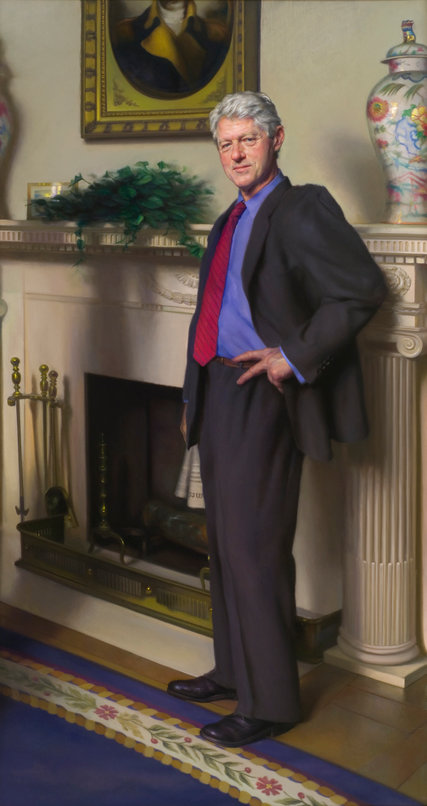With the Clinton's, Only the Shadow Knows
By Maureen Dowd
NYTimes.com

The portrait of Bill
Clinton by Nelson Shanks.
Credit Nelson
Shanks/National Portrait Gallery, via Associated
Press
WASHINGTON — SOMEWHERE in Smithsonian storage sits a portrait of Bill Clinton with two odd features: He is standing next to a shadow meant to conjure Monica Lewinsky’s blue dress, and he is not wearing his gold wedding ring.
As we have been reminded by a recent wild cascade of stories, everything about the Clintons is convoluted. Nothing is simple, even a celebratory portrait.
Nelson Shanks, picked by Clinton to do his portrait for the National Portrait Gallery, revealed to the Philadelphia Daily News that he had used a blue dress on a mannequin to evoke the shadow of the Lewinsky scandal in the portrait.
I called the 77-year-old artist to ask about his devilish punking.
“It’s an extra little kick going on in the painting,” he said. “It was a bit humorous, but there was also a sort of authenticity to it. To do a Pollyanna, basically meaningless, symbolically neutral painting of somebody that has had a powerful influence on society is really copping out.” He said that Clinton’s lack of a wedding band has no ulterior meaning, noting: “I just forgot the ring.” But Clinton aides weren’t buying it.
He said when the omission first made news after the portrait was unveiled in 2006, Hillary Clinton sent him “a lovely little note saying don’t worry about it, this is just a tempest in a teapot.”
In a blog post last week, Eugénie Bisulco, a Clinton administration staffer who led the search team for a White House portrait artist, said it wasn’t Shanks’s attempt to put in “a moral compass” that grated. (The Clintons didn’t even know about that.) Bisulco said that it was that the portrait made Clinton look like “a disheveled Ted Koppel.”
Other Clintonistas dismissed the allegorical shadow as “put-a-bunny-in-the-pot crazy.”
Shanks said it was “like an ice pick going through my back” when he learned that his portrait was “exiled to the dark recesses” in 2009. On a visit to the museum a year and a half ago, he heard a docent telling a tour group that the Clintons put the kibosh on the painting.
He asked Kim Sajet, now director of the National Portrait Gallery, and she confirmed his darkest fears in an email, saying that they took it down because the Clintons disliked it. But, in response to a query, Sajet admitted that she was “repeating unfounded gossip,” according to a spokeswoman, and insisted that the painting is merely in rotation.
Shortly after the art imbroglio broke, an email imbroglio broke. The Times’s Michael Schmidt reported that, as secretary of state, Hillary did not preserve her official correspondence on a government server and exclusively used a private email account. She used a private server linked to her Chappaqua home, only turning over cherry-picked messages in December at the State Department’s request.
Given the paranoid/legalese perspective that permeates Clintonland, this made sense: It’s hard to request emails from an account you don’t know exists. And your own server can shield you from subpoenas and other requests. If you want records from the Clinton server, you have to fight for them. Clinton Inc. can tough it out and even make stuff disappear. Instead of warning the secretary that she could be violating regulations, her aides fetishized her clintonemail.com account as a status symbol. Chelsea took on the pseudonym Diane Reynolds.
Near midnight on Wednesday, Hillary tweeted that she had asked the State Department to release the emails she had coughed up when pressed, noting: “I want the public to see my email.”
Less true words were never spoken.
Schmidt’s scoop followed The Wall Street Journal revelation that at least 60 companies that lobbied the State Department when Hillary was in charge had funneled more than $26 million to the Clinton Foundation.
Certainly, Hillary wants a lot of control. She has spent a lifetime cleaning up messes sparked by her overweening desire for control and her often out-of-control mate. She always feared that her emails could become fodder for critics, and now they have.
Everyone is looking for signs in how Hillary approaches 2016 to see if she’s learned lessons from past trouble. But the minute this story broke, she went back to the bunker, even though she had known for months that the Republicans knew about the account. The usual hatchets — Philippe Reines, David Brock, Lanny Davis and Sidney Blumenthal — got busy.
The Clintons don’t sparkle with honesty and openness. Between his lordly appetites and her queenly prerogatives, you always feel as if there’s something afoot.
Everything needs to be a secret, from the Rose Law Firm records that popped up in a White House closet two years after they were subpoenaed to the formulation of her health care plan.
Yet the Clintons always act as though it’s bad form when you bring up their rule-bending. They want us to compartmentalize, just as they do, to connect the dots that form a pretty picture and leave the other dots alone.
If you’re aspiring to be the second president in the family, why is it so hard to be straight and direct and stand for something? Why can’t you just be upright and steady and good?
Given all the mistakes they’ve made, why do they
keep making them? Why do they somehow never do
anything that doesn’t involve shadows?

